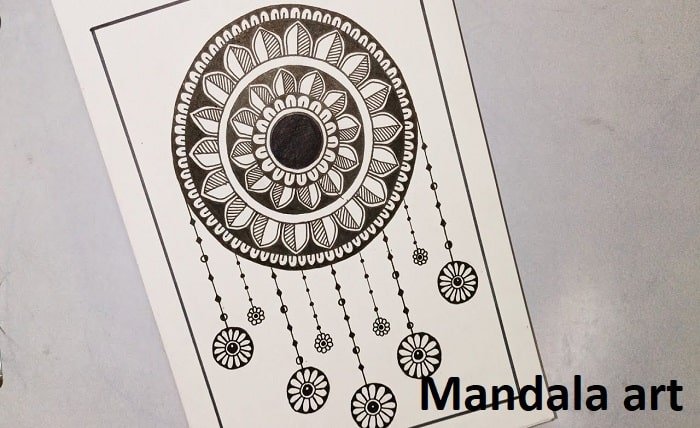Exploring the Beauty and Meaning of Mandala Art: A Journey into Spiritual Creativity

Mandala art is deeply rooted in ancient spiritual traditions, primarily from Hinduism and Buddhism. The word “mandala” originates from Sanskrit, meaning “circle” or “discoid object.” Historically, mandala art served as a spiritual symbol representing the universe, the cosmos, and the divine. These intricate circular patterns were used in temples, rituals, and meditation practices to help devotees focus their minds and souls.
Across various cultures, mandala art played a significant role in religious ceremonies. Tibetan monks created sand mandalas to symbolize the impermanence of life, while Indian traditions used mandalas in yantras to represent deities and cosmic power. Today, mandala art continues to influence spiritual, artistic, and psychological practices globally.
Symbolism and Spiritual Significance of Mandala Art
The symbolic language of mandala art speaks directly to the soul. Every pattern, color, and symmetry carries spiritual significance. Circles, the core of all mandalas, represent wholeness, unity, and the cyclical nature of life. In many cultures, mandala art is considered a sacred space, a spiritual map guiding individuals through life’s journey.
Modern psychology, especially Carl Jung’s theories, adopted mandala art as a therapeutic tool. Jung believed that creating mandalas allowed individuals to explore their unconscious mind. This makes mandala art not just a visual delight but also a spiritual and psychological compass for self-discovery and healing.
Types and Styles of Mandala Art Around the World
The diversity of mandala art is a reflection of its global appeal. While the Tibetan sand mandala is among the most renowned, there are numerous other forms. Hindu mandalas often contain deities and symmetrical geometric patterns, symbolizing cosmic power. Native American dreamcatchers and Aztec sun stones also exhibit mandala-like qualities, showing how mandala art transcends cultural boundaries.
In contemporary times, artists blend traditional designs with modern elements. From minimalistic mandala tattoos to detailed digital illustrations, mandala art evolves with creativity. Despite stylistic differences, all forms of mandala art emphasize symmetry, balance, and spiritual resonance, making each piece universally calming and meaningful.
How Mandala Art Promotes Mental Well-Being
The therapeutic benefits of mandala art are well-documented. Coloring or drawing mandalas has become a popular mindfulness exercise. This meditative process allows individuals to focus on the present moment, reducing anxiety and promoting relaxation. Whether it’s with colored pencils, paints, or digital tools, creating mandala art provides a peaceful escape from daily stress.
Art therapists often incorporate mandala art into sessions for trauma recovery, depression management, and emotional regulation. The process of designing or engaging with mandala art activates both hemispheres of the brain, enhancing cognitive functioning and emotional balance. For many, mandala art becomes a daily ritual of self-care and inner peace.
Mandala Art in Modern Design and Lifestyle
In today’s world, mandala art extends beyond spiritual spaces into mainstream design and culture. From home décor and fashion to corporate branding and tattoo artistry, mandala art has become a staple in aesthetic expression. The symmetry and intricacy of mandala art add a sense of elegance and mindfulness to products and spaces.
Interior designers incorporate mandala art on walls, rugs, and furniture to create serene atmospheres. Fashion designers use mandala patterns in prints, accessories, and even footwear. The global fascination with mandala art reflects a collective yearning for harmony, order, and beauty in an otherwise chaotic world.
Creating Your Own Mandala Art: A Step-by-Step Guide
Anyone can create mandala art, regardless of artistic experience. The process is simple yet transformative. Start with a center point on your paper or canvas. Using a pencil and compass, draw concentric circles and divide them into equal segments like slices of a pie. These are your guiding lines for symmetry in your mandala art.
Next, begin adding patterns—petals, dots, lines, and symbols—starting from the center and working outward. Take your time with each layer. Let the process of building your mandala art be intuitive. Use colors that resonate with your mood or spiritual intention. The final creation is a reflection of your inner world, captured in the mesmerizing language of mandala art.
Mandala Art as a Tool for Meditation and Inner Peace
One of the most profound uses of mandala art is in meditation. Staring into the symmetrical patterns of mandala art helps the mind enter a state of deep concentration. It creates a visual anchor that draws attention inward, aligning thoughts with breath and being. Many spiritual traditions use mandala art as a portal for divine connection and enlightenment.
You don’t need to be a monk or a mystic to experience the meditative benefits of mandala art. Simply set aside a quiet time, light a candle or incense, and gaze at a mandala image. Let your mind absorb the flow of its patterns. Whether observing or creating, mandala art offers a gateway to stillness, clarity, and self-realization.
Conclusion
In a fast-paced world craving meaning and tranquility, mandala art offers both. Its ancient roots, spiritual symbolism, and modern relevance make mandala art a timeless form of creative and emotional expression. From healing trauma to enhancing interior spaces, mandala art transforms the way we see and connect with the world.
As you explore or create mandala art, you engage in more than an artistic act—you participate in a sacred ritual of balance, harmony, and inner peace. Let mandala art guide your journey through mindfulness, creativity, and spiritual growth.
FAQs
Q1: What is the purpose of mandala art?
Mandala art serves as a tool for meditation, spiritual growth, and emotional healing. It symbolizes unity and the cosmos.
Q2: Can beginners create mandala art?
Absolutely! Mandala art is accessible to everyone. You only need basic tools and a calm mindset to start creating your own designs.
Q3: Is mandala art religious?
Mandala art has spiritual roots in Hinduism and Buddhism, but today it’s embraced across cultures for its meditative and aesthetic value.
Q4: How does mandala art help mental health?
Mandala art reduces stress and anxiety by promoting mindfulness and creative focus, often used in therapeutic settings.
Q5: Where can I use mandala art in daily life?
You can incorporate mandala art into home décor, clothing, meditation practices, or as a form of creative journaling and expression.





